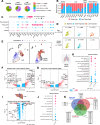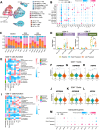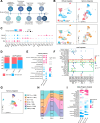Single-cell RNA sequencing identifies molecular biomarkers predicting late progression to CDK4/6 inhibition in patients with HR+/HER2- metastatic breast cancer
- PMID: 39955556
- PMCID: PMC11829392
- DOI: 10.1186/s12943-025-02226-9
Single-cell RNA sequencing identifies molecular biomarkers predicting late progression to CDK4/6 inhibition in patients with HR+/HER2- metastatic breast cancer
Abstract
Background: Cyclin-dependent kinase 4/6 inhibitors (CDK4/6is) in combination with endocrine therapy are the standard treatment for patients with hormone receptor-positive, HER2-negative metastatic breast cancer (mBC). Despite the efficacy of CDK4/6is, intrinsic resistance occurs in approximately one-third of patients, highlighting the need for reliable predictive biomarkers.
Methods: Single-cell RNA sequencing analyzed metastatic tumors from HR+/HER2- mBC patients pre-CDK4/6i treatment at baseline (BL) and/or at disease progression. BL samples were from CDK4/6i responders (median progression-free survival [mPFS] = 25.5 months), while progressors were categorized as early-progressors (EP, mPFS = 3 months) and late-progressors (LP, mPFS = 11 months). Metastatic sites included liver, pleural effusions, ascites, and bone. InferCNV distinguished tumor cells, and functional analysis utilized the Molecular Signatures Database.
Results: LP tumors displayed enhanced Myc, EMT, TNF-α, and inflammatory pathways compared to those EP tumors. Samples from BL and LP responders showed increased tumor-infiltrating CD8+ T cells and natural killer (NK) cells compared to EP non-responders. Notably, despite a high frequency of CD8+ T cells in responding tumors, a functional analysis revealed significant upregulation of genes associated with stress and apoptosis in proliferative CD4+ and CD8+ T cells in BL tumors compared to in EP and LP tumors. These genes, including HSP90 and HSPA8, are linked to resistance to PD1/PD-L1 immune checkpoint inhibitors. A ligand-receptor analysis showed enhanced interactions associated with inhibitory T-cell proliferation (SPP1-CD44) and suppression of immune activity (MDK-NCL) in LP tumors. Longitudinal biopsies consistently revealed dynamic NK cell expansion and enhanced cytotoxic T cell activity, alongside upregulation of immune activity inhibition, in LP tumors compared to in BL tumors. Notably, the predictive biomarker panel from BL tumor cells was validated in 2 independent cohorts, where it consistently predicted a significant improvement in mPFS duration in signature-high versus -low groups.
Conclusion: This study underscores the significance of molecular biomarkers in predicting clinical outcomes to CDK4/6i. Tumor-infiltration CD8+ T and NK cells may also serve as baseline predictors. These insights pave the way for optimizing therapeutic strategies based on microenvironment-specific changes, providing a personalized and effective approach for managing HR+/HER2- mBC and improving patient outcomes.
Keywords: CDK4/6 inhibitor; Drug resistance; Metastatic breast cancer; Outcome prediction; Predictive biomarker; Single-cell RNA-sequencing; Target therapy; Transcriptomics; Tumor microenvironment; Tumor-infiltrating lymphocytes.
© 2025. The Author(s).
Conflict of interest statement
Declarations. Ethics approval and consent to participate: Tumor biopsy samples were collected from patients with HR+/HER2- mBC treated at the University of Texas MD Anderson Cancer Center under the Institutional Review Board (IRB)-approved protocol (PA19-0047). All participants signed informed consent. Clinical data were sourced from electronic medical records (OneConnect and Care Everywhere) and a prospectively maintained Breast Cancer Management System, managed by the Breast Medical Oncology Department from the University of Texas MD Anderson Cancer Center. The validation cohort comprised published sequencing data from Korean patients with HR+/HER2- mBC (NCT03401359) [35]. This cohort included patients with recurrent and/or mBC treated with palbociclib plus endocrine therapy at Samsung Medical Center and Seoul National University Hospital from 2017 to 2020. All participants signed informed consent. Patients who refused to provide informed consent or withdrew from the study were excluded. Competing interests: K.K.: Apeiron, Blueprint Medicines, REPARE, Schrodinger, and Novartis. K.K.H.: Armada Health, AstraZeneca, Cairn Surgical, Eli Lilly & Co, Lumicell. S.D.: EMD Serono, Guardant Health, Novartis, Pfizer, Sermonix, Taiho. D.T.: AstraZeneca, GlaxoSmithKline, Gilead, Novartis, OncoPep, Pfizer, Polyphor, Personalis, Puma Biotechnology, Sermonix, Stemline-Menarini. The rest of the authors declare no competing interests.
Figures







References
-
- Sung H, Ferlay J, Siegel RL, Laversanne M, Soerjomataram I, Jemal A, Bray F. Global cancer statistics 2020: GLOBOCAN estimates of incidence and mortality worldwide for 36 cancers in 185 countries. CA Cancer J Clin. 2021;71(3):209–49. - PubMed
-
- Network, N. C. C. NCCN Guidelines for Breast Cancer V.1.2023; 2023.
-
- Finn RS, Martin M, Rugo HS, Jones S, Im S-A, Gelmon K, Harbeck N, Lipatov ON, Walshe JM, Moulder S. Palbociclib and letrozole in advanced breast cancer. N Engl J Med. 2016;375(20):1925–36. - PubMed
MeSH terms
Substances
Grants and funding
LinkOut - more resources
Full Text Sources
Medical
Research Materials
Miscellaneous

